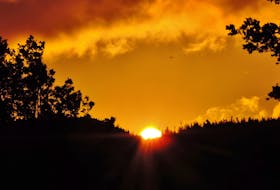It’s been more than a week since we returned to standard time. I hope your internal clock has been able to synchronize with the clock on the wall.
I can only speak for myself, but I love the extra daylight in the morning.
All the talk about time change reminded me that I had a question about the sun, sitting in my inbox. It comes from Sandra Shields. She asks:
How is sunrise/sunset determined? Is it from a specific place in each province? Is sunrise just as the sun completely clears the horizon?
Great questions, Sandra.
Sunrise and sunset are based on when the upper edge of the sun's disc appears to touch the horizon.
The word “appears'' is used because the sun's rays are bent, or refracted, slightly by the Earth's atmosphere.
Spherical trigonometry is used to calculate the times of sunrise and sunset of a specific point on Earth. Scientists begin by determining the correct declination of the sun - that is, its position north or south of the equator, which changes moment by moment (the latitude of the observer does not change).
Next, the semidiurnal arc is calculated; that’s how long it takes the sun, both rising and setting, to get from the horizon to the local meridian. Calculations, which are for an observer at sea level, are then rounded off to the nearest minute.
At a given location and day of the year, the times of sunrise and sunset do not remain constant; our measurement of time goes a little farther awry until corrected each leap year. Every four years, the times should be about the same.
Ever wondered where in the world is the first place to see the sunrise? Well, wonder no longer! North of Gisborne, New Zealand, around the coast to Opotiki and inland to Te Urewera National Park, the East Cape has the honour of witnessing the world's first sunrise every day.
Here’s a fun fact: We always refer to these times as sunrise and sunset times, but those terms are not correct. The sun stays in its position at the centre of our solar system; it doesn't rise or set. It appears to rise and set because the Earth rotates on its axis. It makes one complete turn every 24 hours, turning toward the east.
- Want more weather information? Visit your weather page.
- Have a weather question, photo or drawing to share with Cindy Day? Email [email protected]
Cindy Day is the chief meteorologist for SaltWire Network









